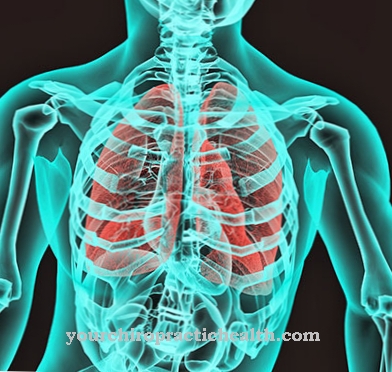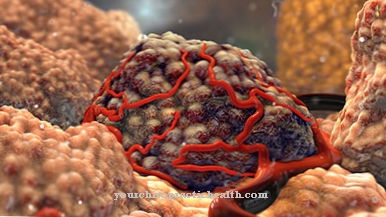A Sunstroke or Insolation is a, often from prolonged and intense exposure to the sun, heat damage. This can lead to severe irritation of the meninges, which are located under the skull. Typical symptoms are nausea, headache, a hot head and dizziness.
What is a sunstroke?

At a Sunstroke, Ictus solis, Heliosis or Insolation heat damage occurs, which is usually caused by intensive and long-lasting exposure to the sun on the neck, neck and head.
In particular, meninges are irritated during exposure to the sun, which in turn causes typical complaints and symptoms.
People and children who are exposed to direct sunlight for long periods on the beach or in nature are particularly prone to sunstroke.
People with light skin and little hair growth, as well as older people, are also more likely to suffer from sunstroke.
causes
As noted briefly, the cause is for one Sunstroke mostly the direct and long-lasting irradiation of the head, neck or neck by the sun. This causes irritation of the meninges, which are located under the skull.
Older people and people with little hair who spend a long time in the sun due to an unprotected head are particularly sensitive. This mostly occurs on the beach, in the outdoor pool or during sports activities. Children also suffer more often from heat stroke due to their comparatively thinner skull bones and light hair.
Symptoms, complaints & ailments
Whether on vacation or at home, everyone wants to enjoy the best time of the year for as long as possible. Finally the sun is shining and it is easy to forget what effects the intense solar radiation can have. If nausea with vomiting, dizziness and circulatory problems occur after spending time outdoors on a warm, sunny day, it may be a sunstroke.
Children and people with bald heads or little hair are particularly affected here, especially if they have enjoyed the sun without their hats. Typical signs are a red face, a hot head and neck pain or a stiff neck. Fever and chills, as well as the other symptoms, only appear after the summer day, usually a few hours later.
Disturbances in consciousness are also possible with severe sunstroke. Young children may develop a high fever and be noticeably pale. Inflammation of the meninges, meningitis, is possible. In the most severe cases, damage to the brain occurs that can lead to a coma. It should be noted that white surfaces such as snow are also dangerous because they reflect sunlight. Since sunstroke symptoms also apply to other diseases, it should be considered whether a long stay in the sun really preceded the symptoms.
Course of disease
In the course of a Sunstroke The typical symptoms such as nausea, headache and dizziness do not set in until a few hours after the intense sun exposure. As a rule, the symptoms and complaints disappear on their own after a short time if the head is kept away from the sun by cooling, shading or covering the head.
However, complications can also arise from a sunstroke. Above all, severe disturbances of consciousness or even loss of consciousness can occur. In very severe cases, cerebral edema can also develop, which in the worst case leads to an increase in pressure in the brain.
As this can lead to respiratory arrest, seizures or even coma, treatment by an emergency doctor or rapid medical help is advisable.
In smaller children, a sunstroke can lead to meningitis, even if it is severe, than meningitis. To avoid irreparable and life-threatening consequences and damage, the head should always be protected from long and direct sunlight.
Complications
In most cases, a sunstroke is uncomplicated if the person concerned moves away from the sun in good time. The symptoms then usually subside without consequences. However, if the person concerned spends too long in the sun, there is a risk of serious consequences.
One possible effect of severe sunstroke is impaired consciousness. This can lead to circulatory collapse and unconsciousness. While some patients appear very excited, others act apathetic or confused. If you lose consciousness, it is important to get the affected person into a stable side position.
Brain edema is one of the most serious complications of sunstroke. Cerebral edema is when fluid collects within the brain tissue, which in turn increases the pressure inside the skull. As a result, a seizure threatens. If important control areas of the brain are affected, there is a risk of respiratory failure. A coma is also possible. Since this is a life-threatening emergency, an emergency doctor must be called immediately.
In younger children, there is a risk that the sunstroke will trigger meningitis. The signs of meningitis in children are often unclear. They suffer from difficulty falling asleep, abdominal pain, tenderness or discomfort and cannot tolerate light or noise. You may also experience vomiting, seizures, fever, and confusion. A quick medical examination is then important.
When should you go to the doctor?
If the person concerned suffers health irregularities from exposure to sunlight, he should protect himself adequately. Staying in the shade, in a cool environment, or taking a cooling shower can help alleviate existing discomfort. If there is an improvement within a short period of time, no doctor needs to be consulted. If you avoid direct sunlight, you will normally recover after a few days. However, if the irregularities continue unabated or if they increase in intensity, medical care is required.
Problems with the functioning of the circulatory system, nausea and vomiting are cause for concern. Fever, headache, redness of the skin on the face, or chills should be presented to a doctor. If there is dizziness, problems in the neck or general malaise, the person concerned needs help.
There is an acute need for action in the event of interruptions in consciousness. An emergency room should be visited as soon as possible or an ambulance service should be alerted. Loss of consciousness is alarming as there is a risk of a comatose state. The necessary measures must be discussed in cooperation with an emergency doctor or under intensive medical care so that no complications occur. Acute sunstroke poses a risk of permanent memory damage. Help is therefore needed as soon as irregularities in memory, coordination or orientation become apparent.
Treatment & Therapy
If the symptoms of a very hot head, nausea, dizziness and headache occur during a long sunbath, it is usually from one Sunstroke to go out. In order to rule out possible complications and brain damage, a medical examination is useful.
The attending physician will then rule out other illnesses through a physical examination and questioning and diagnose sunstroke. The treatment or therapy of a sunstroke then depends on the degree of insolation.
Immediate practical measures are:
- Relocation of the affected person in the shade
- The affected person should lie with their upper body and head elevated
- If possible, cool the neck, head and neck with cold and damp compresses or towels
- Call an emergency doctor immediately if you lose consciousness or lose consciousness
prevention
One Sunstroke can be prevented very well. Sunstroke can usually be prevented, especially with suitable head protection or a parasol. Children in particular should always wear a hat in summer. But the neck and throat should not be exposed to constant sunlight either. Lots of fluids and little physical exertion are also helpful.
Aftercare
A sunstroke is usually easy to treat yourself. Primarily, it is necessary for the person concerned to avoid the sun and stay in the shade or in a cool room. The most common symptoms, such as headaches and overheating of the body, can be relieved by raising the head and upper body.
It is also helpful to put a cool compress on the forehead and neck of the person affected. Staying in a darkened room can also improve the symptoms. If you have a sunstroke, it is important to keep your body hydrated. This stabilizes the person's circulation and lost electrolytes are replenished. Water and tea are best for this.
Fruit varieties that contain water, such as watermelons, also regulate the fluid balance of those affected. Sucking ice cubes can also bring relief in the acute phase. Coffee and alcohol, on the other hand, should definitely be avoided in the event of an acute sunstroke in order not to deprive the body of even more fluid.
Most of all, the body needs rest when sunstroke. Any kind of stress should therefore be avoided. Watching TV for long periods of time and working on the PC strains the eyes and should therefore be kept to a minimum, as should loud noises during the acute phase.
You can do that yourself
Sunstroke is a phenomenon that can be easily treated with self-help. Only severe cases make a doctor's visit necessary. The most important measure is that the person concerned leaves the sun immediately and goes to a shady place or a cool room.
Against headaches and overheating, it is particularly helpful to raise the head and upper body slightly. Applying a cool compress on the forehead and darkening the room can also help speed up symptom relief. Drinking is especially important with a sunstroke. It stabilizes the circulation and helps to restore fluids and electrolytes to the body quickly. Water or tea are ideal here. However, it is better to avoid alcohol and coffee in acute sunstroke. If you don't feel nausea, you can also get fluids through fruits like watermelons.
Rest is very important with sunstroke. It is often associated with irritability, so it is best for patients to avoid any stress. Loud noises are to be avoided as well as straining the eyes from television or working on the PC. Anyone who feels extremely hot can run cold water over their wrists before resting in a quiet room. Sucking an ice cube often brings additional relief for those affected in the acute phase.













.jpg)

.jpg)
.jpg)











.jpg)